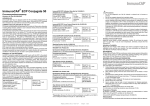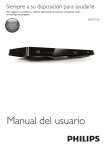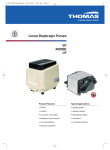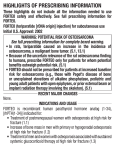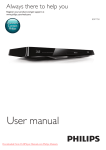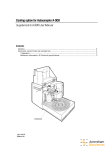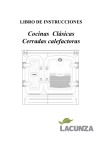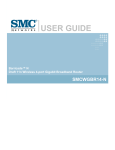Download Preotact, parathyroid hormone
Transcript
ANNEX I SUMMARY OF PRODUCT CHARACTERISTICS 1 1. NAME OF THE MEDICINAL PRODUCT Preotact 100 micrograms powder and solvent for solution for injection. 2. QUALITATIVE AND QUANTITATIVE COMPOSITION Each cartridge contains 1.61 mg parathyroid hormone corresponding to 14 doses. After reconstitution, each dose of 71.4 microlitre contains 100 micrograms parathyroid hormone produced in Escherichia coli by recombinant DNA technology For a full list of excipients, see section 6.1. 3. PHARMACEUTICAL FORM Powder and solvent for solution for injection. White to off-white powder and clear, colourless solvent. 4. CLINICAL PARTICULARS 4.1 Therapeutic indications Preotact is indicated for the treatment of osteoporosis in postmenopausal women at high risk of fractures (see section 5.1). A significant reduction in the incidence of vertebral, but not hip fractures has been demonstrated. 4.2 Posology and method of administration Posology The recommended dose is 100 micrograms of parathyroid hormone administered once-daily Patients should receive supplemental calcium and vitamin D if dietary intake is inadequate. Data support continuous treatment with Preotact for up to 24 months (see section 4.4). Following treatment with Preotact patients can be treated with a bisphosphonate to further increase bone mineral density (see section 5.1). Special populations Renal impairment No dose adjustment is necessary in patients with mild to moderate renal impairment (creatinine clearance 30 to 80 ml/min). There is no data available in patients with severe renal impairment. Preotact should therefore not be used in patients with severe renal impairment (see section 4.3). Hepatic impairment No dose adjustment is needed for patients with mild or moderate hepatic impairment (total score of 7 to 9 on the Child-Pugh scale). There is no data available in patients with severe hepatic impairment. Preotact should therefore not be used in patients with severe hepatic impairment (see section 4.3). Paediatric population The safety and efficacy of Preotact in patients under 18 years have not been studied. There is no relevant use of Preotact in paediatric patients for the treatment of osteoporosis at high risk of fractures 2 Elderly Dose adjustment based upon age is not required (see section 5.2). Method of administration The dose is administered as a subcutaneous injection into the abdomen. Patients must be trained to use the proper injection techniques (see section 6.6). A user manual is available with the Preotact pen to instruct patients on the correct use of the pen. The pen is not included in the packs with cartridges. Precautions to be taken before handling or administering the medicinal product For instructions on reconstitution of the medicinal product before administration, see section 6.6. 4.3 Contraindications Preotact is contraindicated in patients with hypersensitivity to parathyroid hormone or to any of the excipients (see section 6.1) who are receiving or who has previously received radiation therapy to the skeleton with skeletal malignancies or bone metastases. with pre-existing hypercalcemia and other disturbances in the phosphocalcic metabolism with metabolic bone diseases other than primary osteoporosis (including hyperparathyroidism and Paget’s disease of the bone) • with unexplained elevations of bone-specific alkaline phosphatase • with severe renal impairment • with severe hepatic impairment • • • • • 4.4 Special warnings and precautions for use Monitoring of patients during treatment Patients initiated on Preotact therapy should be monitored at months 1, 3 and 6 for elevated levels of serum and/or urinary calcium. Monitoring beyond 6 months is not recommended for patients whose total serum calcium is within the normal limits at 6 months. Elevated serum calcium was observed during Preotact treatment. Serum calcium concentrations reach a maximum between 6 and 8 hours post dose and normally return to baseline by 20 to 24 hours after each administration of parathyroid hormone. Therefore if any blood samples are taken from a patient for monitoring of calcium levels, this should be done at least 20 hours after the most recent injection. Management of elevated serum calcium Patients with persistent elevated serum calcium (above the upper normal level) should be evaluated for underlying disease (e.g. hyperparathyroidism). If no underlying condition is found, the following management procedures should be followed: • • • Calcium and vitamin D supplementation should be withdrawn The frequency of Preotact dosing should be changed to 100 micrograms every other day If elevated levels continue, Preotact therapy should be stopped and the patient monitored until the abnormal values have reverted to normal 3 Caution should be exercised in Patients with pre-existing hypercalciuria Preotact has been studied in patients with pre-existing hypercalciuria. In these patients, Preotact treatment was more likely to exacerbate their underlying hypercalciuria. Patients with urolithiasis Preotact has not been studied in patients with active urolithiasis. Preotact should be used with caution in patients with active or previous urolithiasis. Patients receiving cardiac glucosides Caution should be exercised in patients receiving cardiac glucosides due to the risk of digitalis toxicity if hypercalcemia develops (see section 4.5). Duration of treatment Studies in rats indicate an increased incidence of osteosarcoma with long-term administration of Preotact (see section 5.3). The occurrence of osteosarcoma only occurred at doses that produced systemic exposures > 27-times higher than that observed in humans at the 100 micrograms dose. Until further clinical data becomes available the recommended treatment time of 24 months should not be exceeded. 4.5 Interaction with other medicinal products and other forms of interaction Parathyroid hormone is a natural peptide that is not metabolised by, and does not inhibit hepatic microsomal drug-metabolising enzymes (e.g. cytochrome P450 isoenzymes). Furthermore, parathyroid hormone is not protein bound and has a low volume of distribution. Consequently, no interaction with other medicinal products would be anticipated and no specific drug-drug interactions studies were performed. No potential for drug interactions was identified in the clinical program. From the knowledge of the mechanism of action, combined use of Preotact and cardiac glucosides may predispose patients to digitalis toxicity if hypercalcemia develops (see section 4.4). 4.6 Fertility, pregnancy and lactation There are no data available from the use of parathyroid hormone in women of childbearing potential, during pregnancy and breast feeding. Animal studies of reproductive toxicity are incomplete (see section 5.3). Parathyroid hormone should not be used in women of childbearing potential, during pregnancy or breast-feeding. 4.7 Effects on ability to drive and use machines No studies on the effects on the ability to drive and use machines have been performed. As some episodes of dizziness have been described in patients treated with Preotact, patients should refrain from driving or using machines until symptoms have subsided. 4.8 Undesirable effects The following adverse reaction (ADR) data are based on two placebo-controlled studies involving 2,642 postmenopausal osteoporotic women of whom 1,341 received parathyroid hormone. Approximately 71.4% of the patients on parathyroid hormone reported at least one ADR. Hypercalcemia and/or hypercalciuria reflect the known pharmacodynamic actions of parathyroid hormone in the gastrointestinal tract, the kidney, and the bone. Hypercalcemia was reported in 25.3% of patients and hypercalciuria in 39.3% of patients treated with Preotact. Hypercalcemia was transient and was reported most frequently in the first 3 months of treatment. It was managed during the clinical 4 programme by monitoring laboratory values and the use of a pre-specified management algorithm (see sections 4.3, 4.4, and 5.1). The only other very commonly reported ADR was nausea. The table below gives an overview of the ADRs where the incidence is at least 0.5% higher in the parathyroid hormone group compared to placebo. The following categories are used to rank the adverse reactions by frequency of occurrence: very common (≥1/10); common (≥1/100 to <1/10); uncommon (≥1/1,000 to <1/100); rare (≥ 1/10,000 to <1/1,000); and very rare (<1/10,000), including isolated reports. System organ class Parathyroid hormone N=1341 (%) Infections and infestations Uncommon Influenza 0.5 Metabolism and nutrition disorders Very common Hypercalcemia Common Blood calcium increased Uncommon Blood alkaline phosphatase increased Anorexia Blood uric acid increased 25.3 3.1 0.8 0.6 0.6 Nervous system disorders Common Headache Dizziness Uncommon Dysgeusia Parosmia 9.3 3.9 0.8 0.7 Cardiac disorders Common Palpitations 1.0 Gastrointestinal disorders Very common Nausea Common Vomiting Constipation Dyspepsia Diarrhoea Uncommon Abdominal pain 13.5 2.5 1.8 1.3 1.0 0.8 5 Musculoskeletal and connective tissue disorders Common Muscle cramp Pain in extremity Back pain Renal and urinary disorders Very common Hypercalciuria Common Urine calcium/creatinine ratio increased Urine calcium increased 1.1 1.1 1.0 39.3 2.9 2.2 General disorders and administration site conditions Common Injection site erythema 2.6 Fatigue 1.8 Asthenia 1.2 Uncommon Injection site irritation 0.9 Preotact increases serum uric acid concentrations. For all subjects who received parathyroid hormone 100 micrograms blood uric acid increase was reported for 8 subjects (0.6%) and hyperuricemia was reported for 5 subjects (0.4%). Although gout, arthralgia and nephrolithiasis were reported as ADRs, the relationship to elevations in uric acid due to Preotact administration has not been fully established. Antibodies to parathyroid hormone In a large phase III clinical study, antibodies to parathyroid hormone were detected in 3% of women receiving Preotact compared to 0.2% of women receiving placebo. In these women with a positive titre, there was no evidence of hypersensitivity reactions, allergic reactions, effects on bone mineral density response, or effects on serum calcium. 4.9 Overdose Signs and symptoms In the Preotact clinical program, accidental overdose has been reported. Preotact has been administered in single doses up to 5 micrograms/kg and in repeated doses of up to 3 micrograms/kg/day for 3 days and up to 2.5 micrograms/kg/day for 7 days. The effects of overdose that might be expected include delayed hypercalcemia, nausea, vomiting, dizziness and headache. Overdose management There is no specific antidote for Preotact. Treatment of suspected overdose should include temporary discontinuation of Preotact, monitoring of serum calcium, and implementation of appropriate, supportive measures, such as hydration. Due to the relatively short duration of the pharmacological activity of Preotact further measures should not be necessary. 5. PHARMACOLOGICAL PROPERTIES 5.1 Pharmacodynamic properties Pharmacotherapeutic group: Calcium homeostatis, parathyroid hormones and analogues, ATC code: H05AA03. 6 Mechanism of action Preotact contains recombinant human parathyroid hormone which is identical to the full-length native 84-amino acid polypeptide. Physiological actions of parathyroid hormone include stimulation of bone formation by direct effects on bone forming cells (osteoblasts) indirectly increasing the intestinal absorption of calcium and increasing the tubular reabsorption of calcium and excretion of phosphate by the kidney. Pharmacodynamic effects The skeletal effects of parathyroid hormone depend upon the pattern of systemic exposure. Transient elevations in parathyroid hormone levels after subcutaneous injection of Preotact stimulates new bone formation on trabecular and cortical (periosteal and/or endosteal) bone surfaces by preferential stimulation of osteoblastic activity over osteoclastic activity. Effects on serum calcium concentrations Parathyroid hormone is the principal regulator of serum calcium homeostasis. In response to subcutaneous doses of Preotact (100 micrograms parathyroid hormone), serum total calcium levels increase gradually and reach peak concentration (mean increase in 129 patients, 0.15 mmol/l) at approximately 6 to 8 hours after dosing. In general, serum calcium levels return to baseline levels 24 hours after dosing. Based on two placebo-controlled studies involving 2642 postmenopausal osteoporotic women, hypercalcemia was reported in 25.3% of patients treated with Preotact compared to 4.3% of placebotreated patients. The hypercalcemia was transient and was reported most frequently in the first 3 months of treatment. It was managed during the clinical programme by monitoring laboratory values and the use of a pre-specified management algorithm (see sections 4.3 and 4.4). Clinical efficacy Effect on fracture incidence The pivotal study was an 18-month double-blind, placebo-controlled, phase III study (TOP) of the effect of Preotact on fracture incidence in women with postmenopausal osteoporosis. A total of 2532 patients (1286 Preotact and 1246 placebo), aged 45-94 years (8.1% 45-54 years and 11.4% > 75 years), were randomised to receive 100 micrograms/day or placebo with daily calcium (700 mg) and vitamin D (400 IU) supplementation. Overall, approximately 19% of the subjects in each treatment group had at least 1 prevalent vertebral fracture at baseline. The mean baseline lumbar T score was approximately -3.0 in each treatment group. Of the 2,532 randomised intention-to-treat (ITT) patients, a total of 59 patients experienced at least one new vertebral fracture, placebo: 42 (3.37%) – Preotact: 17 (1.32%), p=0.001. Patients in the Preotact treatment group had a 61% relative risk reduction of a new vertebral fracture at month 18 compared to the patients in the placebo group. To prevent one or more new vertebral fractures, 48 women had to be treated for a median of 18 months for the total population. For patients with pre-existing fractures, number needed to treat (NNT) is 21 patients. There was no significant difference between the treatment groups in the incidence of any non-vertebral clinical fracture: 5.52% for Preotact vs. 5.86% for placebo. The most relevant fracture reduction was observed among patients at high risk of fractures such as patients with previous fractures and in patients with a lumbar spine T-score of < - 3. 7 Relatively few patients less than 5 years postmenopausal and 45-54 years of age were enrolled in the phase III study (2-3%). The results for these subjects were not different from the results in the study as a whole. Effect on bone mineral density (BMD) In the pivotal study, Preotact increased BMD in the lumbar spine after 18 months treatment by 6.5% compared with -0.3% for placebo (p<0.001). Significant increases in hip BMD (total, femoral neck, trochanter) were observed at study endpoint; 1.0, 1.8 and 1.0%, respectively, for Preotact versus -1.1, 0.7 and -0.6% for placebo (p<0.001). Continued treatment for up to 24 months in an open-label extension of this study resulted in a continued increase in BMD. The increase from baseline in lumbar spine and femoral neck BMD was 6.8% and 2.2%, respectively in patients treated with Preotact. The effects of Preotact on bone architecture were evaluated using quantitative computed tomography (QCT) and peripheral QCT. Volumetric trabecular BMD at the lumbar spine increased by 38% over baseline at 18 months. Similarly, volumetric trabecular BMD at the total hip increased by 4.7%. Similar increases occurred at the femoral neck, trochanter, and intertrochanter. Treatment with Preotact reduced volumetric cortical bone BMD (measured at the distal radius and mid-shaft tibia), while periosteal circumference or indices of cortical bone strength were maintained. In the 24-month alendronate combination therapy study (PaTH), the effects of Preotact on bone architecture were also evaluated using QCT. Volumetric trabecular BMD at the lumbar spine increased by 26, 13, and 11% (Preotact, Preotact and alendronate and alendronate, respectively) over baseline at 12 months. Similarly, volumetric trabecular BMD at the total hip increased by 9, 6, and 2%, respectively, in the 3 groups. Treatment of osteoporosis with combination and sequential therapy The PaTH study was a National Institute of Health (NIH) sponsored randomised, placebo-controlled, 2 year, multicenter, double-blind trial of Preotact and alendronate as monotherapy and in combination for the treatment of postmenopausal osteoporosis. Inclusion criteria were; women between 55 and 85 years of age with BMD T-scores below -2.5 or below -2 and at least one additional risk factor for fracture. All women were given calcium (400-500 mg) and vitamin D (400 IU) supplements. A total of 238 postmenopausal women, were randomly assigned to one of the following treatment groups; Preotact (100 micrograms parathyroid hormone), alendronate (10 mg), or the combination of both, and followed for 12 months. In the second year of the study women in the original Preotact group were randomly assigned to receive either alendronate or matching placebo, and women in the other two groups received alendronate. At baseline a total of 165 women (69%) had a T-score below –2.5, and 112 (47%) reported at least one fracture after menopause. One year of therapy, showed the following results: the increases in lumbar spine BMD above baseline were similar in the Preotact and combination-therapy groups (6.3 and 6.1%, respectively), but were somewhat smaller in the alendronate group (4.6%). Increases in BMD at the total hip were 0.3, 1.9, and 3.0% for the 3 groups, respectively. At the end of year 2 (12 months after Preotact was discontinued), there was a 12.1% mean increase in dual energy X-ray absorptiometry (DXA) spine BMD for patients who received alendronate for the second year. For the patients who received placebo during the second year, the mean percent increase was 4.1% compared to baseline, but had decreased slightly compared to the end of 12 months of Preotact treatment. For the mean change in hip BMD, there was a 4.5% increase from baseline with one year of alendronate compared to a 0.1% decrease after one year of placebo. 8 Preotact in combination with hormone replacement therapy (HRT) in 180 postmenopausal women has been shown to significantly increase lumbar spine BMD at 12 months compared with HRT alone (7.1 % vs. 1.1%, p<0.001). The combination was effective regardless of age, baseline rate of bone turnover, or baseline BMD. 5.2 Pharmacokinetic properties Absorption Subcutaneous administration of 100 micrograms of parathyroid hormone into the abdomen produces a rapid increase in plasma parathyroid hormone levels and achieves a peak at 1 to 2 hours after dosing. The average half-life is of about 1.5 hours. The absolute bioavailability of 100 micrograms of parathyroid hormone after subcutaneous administration in the abdomen is 55%. Distribution The volume of distribution at steady-state following intravenous administration is approximately 5.4 l. Interindividual variability in the volume of distribution of parathyroid hormone is about 40%. Biotransformation Parathyroid hormone is efficiently removed from the blood by a receptor-mediated process in the liver and is broken down into smaller peptide fragments. The fragments derived from the amino-terminus are further degraded within the cell while the fragments derived from the carboxy-terminius are released back into the blood and cleared by the kidney. These carboxy-terminal fragments are thought to play a role in the regulation of parathyroid hormone activity. Under normal physiologic conditions, full-length parathyroid hormone (1-84) constitutes only 5-30% of the circulating forms of the molecule, while 70-95% is present as carboxy-terminal fragments. Following a subcutaneous dose of Preotact, C-terminal fragments make up about 60-90% of the circulating forms of the molecule. Systemic clearance of parathyroid hormone (45.3 l/hour) following an intravenous dose is close to normal liver plasma flow and is consistent with extensive hepatic metabolism of the active substance. Interindividual variability in systemic clearance is about 15%. Elimination Parathyroid hormone is metabolised in the liver and to a lesser degree in the kidney. Parathyroid hormone is not excreted from the body in its intact form. Circulating carboxy-terminal fragments are filtered by the kidney, but are subsequently broken to even smaller fragments during tubular reuptake. Hepatic impairment There was a modest increase of about 20% in the mean baseline corrected exposure (AUC) to parathyroid hormone in a study conducted in 6 men and 6 women with moderate hepatic impairment as compared with a matched group of 12 subjects with normal hepatic function. No studies have been conducted in patients with severe hepatic impairment. Renal impairment The overall exposure and Cmax of parathyroid hormone were slightly increased (22% and 56%, respectively) in a group of 8 male and 8 female subjects with mild-to-moderate renal impairment (creatinine clearances of 30 to 80 ml/min) compared with a matched group of 16 subjects with normal renal function. The pharmacokinetics of parathyroid hormone in patients with severe renal impairment (creatinine clearance of less than 30 ml/min) has not been investigated. Elderly No differences in Preotact pharmacokinetics were detected with regard to age (range 47-88 years). Dosage adjustment based on age is not required. 9 Gender The medicinal product has only been studied in postmenopausal women. 5.3 Preclinical safety data Preclinical data reveal no special hazard for humans based on conventional studies of safety pharmacology, mutagenicity, toxicity to fertility and general reproduction, and local tolerance. In monkeys receiving daily subcutaneous doses for 6 months, there was an increased occurrence of renal tubular mineralization at exposure levels below clinical exposure levels. Rats treated with near life-time daily injections had dose-dependent exaggerated bone formation and an increased incidence of bone tumours, including osteosarcoma, most probably due to an epigenetic mechanism. Due to the differences in bone physiology in rats and humans, the clinical relevance of these findings is probably minor. No osteosarcomas have been observed in clinical trials. There are no studies of foetal, developmental, perinatal or postnatal toxicity. It is unknown whether recombinant human parathyroid hormone is excreted in the milk of lactating animals. 6. PHARMACEUTICAL PARTICULARS 6.1 List of excipients Powder Mannitol Citric acid monohydrate Sodium chloride Hydrochloric acid, dilute (for pH adjustment) Sodium hydroxide (for pH adjustment) Solvent Metacresol Water for injections 6.2 Incompatibilities Not applicable. 6.3 Shelf life 30 months Reconstituted solution: chemical and physical in-use stability has been demonstrated for 28 days at 28°C. During the 28-day period the reconstituted solution can be stored for up to 7 days at temperatures below 25°C. 6.4 Special precautions for storage Do not store above 25°C. Do not freeze. Keep the cartridge in the outer carton in order to protect from light. Reconstituted solution: Store in a refrigerator (2-8°C). Do not freeze. Once the cartridge is reconstituted it can be stored outside the refrigerator at temperatures below 25°C for up to 7 days during the 28 day use period (see section 6.3). 10 6.5 Nature and contents of container The medicinal product is supplied in a dual-chamber cartridge. The container closure system is comprised of a dual-chamber cartridge, a center stopper, a crimp cap (containing a rubber seal) sealing the first chamber containing lyophilised powder and an end stopper sealing the second chamber containing the solvent for mixing. Cartridge: The glass of the dual-chamber cartridge is made of glass Type I. Stopper (center and end): The stopper is made of bromobutyl rubber, grey. Crimp cap (containing a rubber seal): The crimp cap is made of aluminium and the rubber seal is made of bromobutyl rubber. Each dual-chamber cartridge contains 1.61 mg parathyroid hormone and 1.13 ml solvent (14 doses). Preotact is available in packs of 2 and 6 cartridges. Not all pack sizes may be marketed. The Preotact pen and needles are not included. 6.6 Special precautions for disposal and other handling Preotact is injected using the re-usable pen, Preotact pen. The content of the dual-chamber cartridge is reconstituted in the Preotact pen. After reconstitution the liquid should be clear and colourless. DO NOT SHAKE; shaking may cause denaturation of the active substance. If the reconstituted solution is cloudy, coloured or contains particles the cartridge should be removed from the Preotact pen and a new cartridge inserted. Any unused product or waste material should be disposed of in accordance with local requirements. 7. MARKETING AUTHORISATION HOLDER Nycomed Danmark ApS Langebjerg 1 DK-4000 Roskilde Denmark 8. MARKETING AUTHORISATION NUMBER(S) EU/1/06/339/001-002 9. DATE OF FIRST AUTHORISATION/RENEWAL OF THE AUTHORISATION Date of first authorisation: 24.04.2006 Date of latest renewal: 24.04.2011 10. DATE OF REVISION OF THE TEXT Detailed information on this product is available on the website of the European Medicines Agency http://www.ema.europa.eu 11 1. NAME OF THE MEDICINAL PRODUCT Preotact 100 micrograms powder and solvent for solution for injection in a pre-filled pen. 2. QUALITATIVE AND QUANTITATIVE COMPOSITION Each pre-filled pen contains 1.61 mg parathyroid hormone corresponding to 14 doses. After reconstitution, each dose of 71.4 microlitre contains 100 micrograms parathyroid hormone produced in Escherichia coli by recombinant DNA technology For a full list of excipients, see section 6.1. 3. PHARMACEUTICAL FORM Powder and solvent for solution for injection. White to off-white powder and clear, colourless solvent. 4. CLINICAL PARTICULARS 4.1 Therapeutic indications Preotact is indicated for the treatment of osteoporosis in postmenopausal women at high risk of fractures (see section 5.1). A significant reduction in the incidence of vertebral, but not hip fractures has been demonstrated. 4.2 Posology and method of administration Posology The recommended dose is 100 micrograms of parathyroid hormone administered once-daily Patients should receive supplemental calcium and vitamin D if dietary intake is inadequate. Data support continuous treatment with Preotact for up to 24 months (see section 4.4). Following treatment with Preotact patients can be treated with a bisphosphonate to further increase bone mineral density (see section 5.1). Special populations Renal impairment No dose adjustment is necessary in patients with mild to moderate renal impairment (creatinine clearance 30 to 80 ml/min). There is no data available in patients with severe renal impairment. Preotact should therefore not be used in patients with severe renal impairment (see section 4.3). Hepatic impairment No dose adjustment is needed for patients with mild or moderate hepatic impairment (total score of 7 to 9 on the Child-Pugh scale). There is no data available in patients with severe hepatic impairment. Preotact should therefore not be used in patients with severe hepatic impairment (see section 4.3). Paediatric population 12 The safety and efficacy of Preotact in patients under 18 years have not been studied. There is no relevant use of Preotact in paediatric patients for the treatment of osteoporosis at high risk of fractures Elderly Dose adjustment based upon age is not required (see section 5.2). Method of administration The dose is administered as a subcutaneous injection into the abdomen. Patients must be trained to use the proper injection techniques (see section 6.6). A user manual is included in the box to instruct patients on the correct use of the pen. Precautions to be taken before handling or administering the medicinal product For instructions on reconstitution of the medicinal product before administration, see section 6.6. 4.3 Contraindications Preotact is contraindicated in patients with hypersensitivity to parathyroid hormone or to any of the excipients (see section 6.1) who are receiving or who has previously received radiation therapy to the skeleton with skeletal malignancies or bone metastases. with pre-existing hypercalcemia and other disturbances in the phosphocalcic metabolism with metabolic bone diseases other than primary osteoporosis (including hyperparathyroidism and Paget’s disease of the bone) • with unexplained elevations of bone-specific alkaline phosphatase • with severe renal impairment • with severe hepatic impairment • • • • • 4.4 Special warnings and precautions for use Monitoring of patients during treatment Patients initiated on Preotact therapy should be monitored at months 1, 3 and 6 for elevated levels of serum and/or urinary calcium. Monitoring beyond 6 months is not recommended for patients whose total serum calcium is within the normal limits at 6 months. Elevated serum calcium was observed during Preotact treatment. Serum calcium concentrations reach a maximum between 6 and 8 hours post dose and normally return to baseline by 20 to 24 hours after each administration of parathyroid hormone. Therefore if any blood samples are taken from a patient for monitoring of calcium levels, this should be done at least 20 hours after the most recent injection. Management of elevated serum calcium Patients with persistent elevated serum calcium (above the upper normal level) should be evaluated for underlying disease (e.g. hyperparathyroidism). If no underlying condition is found, the following management procedures should be followed: • • • Calcium and vitamin D supplementation should be withdrawn The frequency of Preotact dosing should be changed to 100 micrograms every other day If elevated levels continue, Preotact therapy should be stopped and the patient monitored until the abnormal values have reverted to normal 13 Caution should be exercised in Patients with pre-existing hypercalciuria Preotact has been studied in patients with pre-existing hypercalciuria. In these patients, Preotact treatment was more likely to exacerbate their underlying hypercalciuria. Patients with urolithiasis Preotact has not been studied in patients with active urolithiasis. Preotact should be used with caution in patients with active or previous urolithiasis. Patients receiving cardiac glucosides Caution should be exercised in patients receiving cardiac glucosides due to the risk of digitalis toxicity if hypercalcemia develops (see section 4.5). Duration of treatment Studies in rats indicate an increased incidence of osteosarcoma with long-term administration of Preotact (see section 5.3). The occurrence of osteosarcoma only occurred at doses that produced systemic exposures > 27-times higher than that observed in humans at the 100 micrograms dose. Until further clinical data becomes available the recommended treatment time of 24 months should not be exceeded. 4.5 Interaction with other medicinal products and other forms of interaction Parathyroid hormone is a natural peptide that is not metabolised by, and does not inhibit hepatic microsomal drug-metabolising enzymes (e.g. cytochrome P450 isoenzymes). Furthermore, parathyroid hormone is not protein bound and has a low volume of distribution. Consequently, no interaction with other medicinal products would be anticipated and no specific drug-drug interactions studies were performed. No potential for drug interactions was identified in the clinical program. From the knowledge of the mechanism of action, combined use of Preotact and cardiac glucosides may predispose patients to digitalis toxicity if hypercalcemia develops (see section 4.4). 4.6 Fertility, pregnancy and lactation There are no data available from the use of parathyroid hormone in women of childbearing potential, during pregnancy and breast feeding. Animal studies of reproductive toxicity are incomplete (see section 5.3). Parathyroid hormone should not be used in women of childbearing potential, during pregnancy or breast-feeding. 4.7 Effects on ability to drive and use machines No studies on the effects on the ability to drive and use machines have been performed. As some episodes of dizziness have been described in patients treated with Preotact, patients should refrain from driving or using machines until symptoms have subsided. 4.8 Undesirable effects The following adverse reaction (ADR) data are based on two placebo-controlled studies involving 2,642 postmenopausal osteoporotic women of whom 1,341 received parathyroid hormone. Approximately 71.4% of the patients on parathyroid hormone reported at least one ADR. Hypercalcemia and/or hypercalciuria reflect the known pharmacodynamic actions of parathyroid hormone in the gastrointestinal tract, the kidney, and the bone. Hypercalcemia was reported in 25.3% of patients and hypercalciuria in 39.3% of patients treated with Preotact. Hypercalcemia was transient and was reported most frequently in the first 3 months of treatment. It was managed during the clinical 14 programme by monitoring laboratory values and the use of a pre-specified management algorithm (see sections 4.3, 4.4, and 5.1). The only other very commonly reported ADR was nausea. The table below gives an overview of the ADRs where the incidence is at least 0.5% higher in the parathyroid hormone group compared to placebo. The following categories are used to rank the adverse reactions by frequency of occurrence: very common (≥1/10); common (≥1/100 to <1/10); uncommon (≥1/1,000 to <1/100); rare (≥ 1/10,000 to <1/1,000); and very rare (<1/10,000), including isolated reports. System organ class Parathyroid hormone N=1341 (%) Infections and infestations Uncommon Influenza 0.5 Metabolism and nutrition disorders Very common Hypercalcemia Common Blood calcium increased Uncommon Blood alkaline phosphatase increased Anorexia Blood uric acid increased 25.3 3.1 0.8 0.6 0.6 Nervous system disorders Common Headache Dizziness Uncommon Dysgeusia Parosmia 9.3 3.9 0.8 0.7 Cardiac disorders Common Palpitations 1.0 Gastrointestinal disorders Very common Nausea Common Vomiting Constipation Dyspepsia Diarrhoea Uncommon Abdominal pain 13.5 2.5 1.8 1.3 1.0 0.8 15 Musculoskeletal and connective tissue disorders Common Muscle cramp Pain in extremity Back pain Renal and urinary disorders Very common Hypercalciuria Common Urine calcium/creatinine ratio increased Urine calcium increased 1.1 1.1 1.0 39.3 2.9 2.2 General disorders and administration site conditions Common Injection site erythema 2.6 Fatigue 1.8 Asthenia 1.2 Uncommon Injection site irritation 0.9 Preotact increases serum uric acid concentrations. For all subjects who received parathyroid hormone 100 micrograms blood uric acid increase was reported for 8 subjects (0.6%) and hyperuricemia was reported for 5 subjects (0.4%). Although gout, arthralgia and nephrolithiasis were reported as ADRs, the relationship to elevations in uric acid due to Preotact administration has not been fully established. Antibodies to parathyroid hormone In a large phase III clinical study, antibodies to parathyroid hormone were detected in 3% of women receiving Preotact compared to 0.2% of women receiving placebo. In these women with a positive titre, there was no evidence of hypersensitivity reactions, allergic reactions, effects on bone mineral density response, or effects on serum calcium. 4.9 Overdose Signs and symptoms In the Preotact clinical program, accidental overdose has been reported. Preotact has been administered in single doses up to 5 micrograms/kg and in repeated doses of up to 3 micrograms/kg/day for 3 days and up to 2.5 micrograms/kg/day for 7 days. The effects of overdose that might be expected include delayed hypercalcemia, nausea, vomiting, dizziness and headache. Overdose management There is no specific antidote for Preotact. Treatment of suspected overdose should include temporary discontinuation of Preotact, monitoring of serum calcium, and implementation of appropriate, supportive measures, such as hydration. Due to the relatively short duration of the pharmacological activity of Preotact further measures should not be necessary. 5. PHARMACOLOGICAL PROPERTIES 5.1 Pharmacodynamic properties Pharmacotherapeutic group: Calcium homeostatis, parathyroid hormones and analogues, ATC code: H05AA03. 16 Mechanism of action Preotact contains recombinant human parathyroid hormone which is identical to the full-length native 84-amino acid polypeptide. Physiological actions of parathyroid hormone include stimulation of bone formation by direct effects on bone forming cells (osteoblasts) indirectly increasing the intestinal absorption of calcium and increasing the tubular reabsorption of calcium and excretion of phosphate by the kidney. Pharmacodynamic effects The skeletal effects of parathyroid hormone depend upon the pattern of systemic exposure. Transient elevations in parathyroid hormone levels after subcutaneous injection of Preotact stimulates new bone formation on trabecular and cortical (periosteal and/or endosteal) bone surfaces by preferential stimulation of osteoblastic activity over osteoclastic activity. Effects on serum calcium concentrations Parathyroid hormone is the principal regulator of serum calcium homeostasis. In response to subcutaneous doses of Preotact (100 micrograms parathyroid hormone), serum total calcium levels increase gradually and reach peak concentration (mean increase in 129 patients, 0.15 mmol/l) at approximately 6 to 8 hours after dosing. In general, serum calcium levels return to baseline levels 24 hours after dosing. Based on two placebo-controlled studies involving 2642 postmenopausal osteoporotic women, hypercalcemia was reported in 25.3% of patients treated with Preotact compared to 4.3% of placebotreated patients. The hypercalcemia was transient and was reported most frequently in the first 3 months of treatment. It was managed during the clinical programme by monitoring laboratory values and the use of a pre-specified management algorithm (see sections 4.3 and 4.4). Clinical efficacy Effect on fracture incidence The pivotal study was an 18-month double-blind, placebo-controlled, phase III study (TOP) of the effect of Preotact on fracture incidence in women with postmenopausal osteoporosis. A total of 2532 patients (1286 Preotact and 1246 placebo), aged 45-94 years (8.1% 45-54 years and 11.4% > 75 years), were randomised to receive 100 micrograms/day or placebo with daily calcium (700 mg) and vitamin D (400 IU) supplementation. Overall, approximately 19% of the subjects in each treatment group had at least 1 prevalent vertebral fracture at baseline. The mean baseline lumbar T score was approximately -3.0 in each treatment group. Of the 2,532 randomised intention-to-treat (ITT) patients, a total of 59 patients experienced at least one new vertebral fracture, placebo: 42 (3.37%) – Preotact: 17 (1.32%), p=0.001. Patients in the Preotact treatment group had a 61% relative risk reduction of a new vertebral fracture at month 18 compared to the patients in the placebo group. To prevent one or more new vertebral fractures, 48 women had to be treated for a median of 18 months for the total population. For patients with pre-existing fractures, number needed to treat (NNT) is 21 patients. There was no significant difference between the treatment groups in the incidence of any non-vertebral clinical fracture: 5.52% for Preotact vs. 5.86% for placebo. The most relevant fracture reduction was observed among patients at high risk of fractures such as patients with previous fractures and in patients with a lumbar spine T-score of < - 3. 17 Relatively few patients less than 5 years postmenopausal and 45-54 years of age were enrolled in the phase III study (2-3%). The results for these subjects were not different from the results in the study as a whole. Effect on bone mineral density (BMD) In the pivotal study, Preotact increased BMD in the lumbar spine after 18 months treatment by 6.5% compared with -0.3% for placebo (p<0.001). Significant increases in hip BMD (total, femoral neck, trochanter) were observed at study endpoint; 1.0, 1.8 and 1.0%, respectively, for Preotact versus -1.1, 0.7 and -0.6% for placebo (p<0.001). Continued treatment for up to 24 months in an open-label extension of this study resulted in a continued increase in BMD. The increase from baseline in lumbar spine and femoral neck BMD was 6.8% and 2.2%, respectively in patients treated with Preotact. The effects of Preotact on bone architecture were evaluated using quantitative computed tomography (QCT) and peripheral QCT. Volumetric trabecular BMD at the lumbar spine increased by 38% over baseline at 18 months. Similarly, volumetric trabecular BMD at the total hip increased by 4.7%. Similar increases occurred at the femoral neck, trochanter, and intertrochanter. Treatment with Preotact reduced volumetric cortical bone BMD (measured at the distal radius and mid-shaft tibia), while periosteal circumference or indices of cortical bone strength were maintained. In the 24-month alendronate combination therapy study (PaTH), the effects of Preotact on bone architecture were also evaluated using QCT. Volumetric trabecular BMD at the lumbar spine increased by 26, 13, and 11% (Preotact, Preotact and alendronate and alendronate, respectively) over baseline at 12 months. Similarly, volumetric trabecular BMD at the total hip increased by 9, 6, and 2%, respectively, in the 3 groups. Treatment of osteoporosis with combination and sequential therapy The PaTH study was a National Institute of Health (NIH) sponsored randomised, placebo-controlled, 2 year, multicenter, double-blind trial of Preotact and alendronate as monotherapy and in combination for the treatment of postmenopausal osteoporosis. Inclusion criteria were; women between 55 and 85 years of age with BMD T-scores below -2.5 or below -2 and at least one additional risk factor for fracture. All women were given calcium (400-500 mg) and vitamin D (400 IU) supplements. A total of 238 postmenopausal women, were randomly assigned to one of the following treatment groups; Preotact (100 micrograms parathyroid hormone), alendronate (10 mg), or the combination of both, and followed for 12 months. In the second year of the study women in the original Preotact group were randomly assigned to receive either alendronate or matching placebo, and women in the other two groups received alendronate. At baseline a total of 165 women (69%) had a T-score below –2.5, and 112 (47%) reported at least one fracture after menopause. One year of therapy, showed the following results: the increases in lumbar spine BMD above baseline were similar in the Preotact and combination-therapy groups (6.3 and 6.1%, respectively), but were somewhat smaller in the alendronate group (4.6%). Increases in BMD at the total hip were 0.3, 1.9, and 3.0% for the 3 groups, respectively. At the end of year 2 (12 months after Preotact was discontinued), there was a 12.1% mean increase in dual energy X-ray absorptiometry (DXA) spine BMD for patients who received alendronate for the second year. For the patients who received placebo during the second year, the mean percent increase was 4.1% compared to baseline, but had decreased slightly compared to the end of 12 months of Preotact treatment. For the mean change in hip BMD, there was a 4.5% increase from baseline with one year of alendronate compared to a 0.1% decrease after one year of placebo. 18 Preotact in combination with hormone replacement therapy (HRT) in 180 postmenopausal women has been shown to significantly increase lumbar spine BMD at 12 months compared with HRT alone (7.1 % vs. 1.1%, p<0.001). The combination was effective regardless of age, baseline rate of bone turnover, or baseline BMD. 5.2 Pharmacokinetic properties Absorption Subcutaneous administration of 100 micrograms of parathyroid hormone into the abdomen produces a rapid increase in plasma parathyroid hormone levels and achieves a peak at 1 to 2 hours after dosing. The average half-life is of about 1.5 hours. The absolute bioavailability of 100 micrograms of parathyroid hormone after subcutaneous administration in the abdomen is 55%. Distribution The volume of distribution at steady-state following intravenous administration is approximately 5.4 l. Interindividual variability in the volume of distribution of parathyroid hormone is about 40%. Biotransformation Parathyroid hormone is efficiently removed from the blood by a receptor-mediated process in the liver and is broken down into smaller peptide fragments. The fragments derived from the amino-terminus are further degraded within the cell while the fragments derived from the carboxy-terminius are released back into the blood and cleared by the kidney. These carboxy-terminal fragments are thought to play a role in the regulation of parathyroid hormone activity. Under normal physiologic conditions, full-length parathyroid hormone (1-84) constitutes only 5-30% of the circulating forms of the molecule, while 70-95% is present as carboxy-terminal fragments. Following a subcutaneous dose of Preotact, C-terminal fragments make up about 60-90% of the circulating forms of the molecule. Systemic clearance of parathyroid hormone (45.3 l/hour) following an intravenous dose is close to normal liver plasma flow and is consistent with extensive hepatic metabolism of the active substance. Interindividual variability in systemic clearance is about 15%. Elimination Parathyroid hormone is metabolised in the liver and to a lesser degree in the kidney. Parathyroid hormone is not excreted from the body in its intact form. Circulating carboxy-terminal fragments are filtered by the kidney, but are subsequently broken to even smaller fragments during tubular reuptake. Hepatic impairment There was a modest increase of about 20% in the mean baseline corrected exposure (AUC) to parathyroid hormone in a study conducted in 6 men and 6 women with moderate hepatic impairment as compared with a matched group of 12 subjects with normal hepatic function. No studies have been conducted in patients with severe hepatic impairment. Renal impairment The overall exposure and Cmax of parathyroid hormone were slightly increased (22% and 56%, respectively) in a group of 8 male and 8 female subjects with mild-to-moderate renal impairment (creatinine clearances of 30 to 80 ml/min) compared with a matched group of 16 subjects with normal renal function. The pharmacokinetics of parathyroid hormone in patients with severe renal impairment (creatinine clearance of less than 30 ml/min) has not been investigated. Elderly No differences in Preotact pharmacokinetics were detected with regard to age (range 47-88 years). Dosage adjustment based on age is not required. 19 Gender The medicinal product has only been studied in postmenopausal women. 5.3 Preclinical safety data Preclinical data reveal no special hazard for humans based on conventional studies of safety pharmacology, mutagenicity, toxicity to fertility and general reproduction, and local tolerance. In monkeys receiving daily subcutaneous doses for 6 months, there was an increased occurrence of renal tubular mineralization at exposure levels below clinical exposure levels. Rats treated with near life-time daily injections had dose-dependent exaggerated bone formation and an increased incidence of bone tumours, including osteosarcoma, most probably due to an epigenetic mechanism. Due to the differences in bone physiology in rats and humans, the clinical relevance of these findings is probably minor. No osteosarcomas have been observed in clinical trials. There are no studies of foetal, developmental, perinatal or postnatal toxicity. It is unknown whether recombinant human parathyroid hormone is excreted in the milk of lactating animals. 6. PHARMACEUTICAL PARTICULARS 6.1 List of excipients Powder Mannitol Citric acid monohydrate Sodium chloride Hydrochloric acid, dilute (for pH adjustment) Sodium hydroxide (for pH adjustment) Solvent Metacresol Water for injections 6.2 Incompatibilities Not applicable. 6.3 Shelf life 30 months Reconstituted solution: chemical and physical in-use stability has been demonstrated for 28 days at 28°C. During the 28-day period the reconstituted solution can be stored for up to 7 days at temperatures below 25°C. 6.4 Special precautions for storage Do not store above 25°C. Do not freeze. Keep the product protected from light. Reconstituted solution: Store in a refrigerator (2-8°C). Do not freeze. Once the product is reconstituted it can be stored outside the refrigerator at temperatures below 25°C for up to 7 days during the 28 day use period (see section 6.3). 20 6.5 Nature and contents of container The medicinal product is supplied in a pre-filled pen containing a dual-chamber cartridge. The container closure system is comprised of a dual-chamber cartridge, a center stopper, a crimp cap (containing a rubber seal) sealing the first chamber containing lyophilised powder and an end stopper sealing the second chamber containing the solvent for mixing. Cartridge: Glass Type I. Stopper (center and end): Bromobutyl rubber, grey. Crimp cap (containing a rubber seal): Aluminium .The rubber seal is made of bromobutyl rubber. Each cartridge inside the prefilled pen contains 1.61 mg parathyroid hormone and 1.13 ml solvent (14 doses). Preotact is available in packs of 2 pre-filled pens. 6.6 Special precautions for disposal and other handling Preotact is injected using a pre-filled pen. Each pen should be used by only one patient. A new sterile needle must be used for every injection. The pen can be used with standard injection pen needles. The content of the cartridge is reconstituted in the pen. After reconstitution the liquid should be clear and colourless. DO NOT SHAKE; shaking may cause denaturation of the active substance. Preotact should not be used if the reconstituted solution is cloudy, coloured or contains particles. Please see how to use the pen in the Instructions for use manual. Any unused product or waste material should be disposed of in accordance with local requirements. 7. MARKETING AUTHORISATION HOLDER Nycomed Danmark ApS Langebjerg 1 DK-4000 Roskilde Denmark 8. MARKETING AUTHORISATION NUMBER(S) 9. DATE OF FIRST AUTHORISATION/RENEWAL OF THE AUTHORISATION Date of first authorisation: 24.04.2006 Date of latest renewal: 24.04.2011 10. DATE OF REVISION OF THE TEXT Detailed information on this product is available on the website of the European Medicines Agency http://www.ema.europa.eu 21 ANNEX II A. MANUFACTURER OF THE BIOLOGICAL ACTIVE SUBSTANCE AND MANUFACTURING AUTHORISATION HOLDER RESPONSIBLE FOR BATCH RELEASE B. CONDITIONS OF THE MARKETING AUTHORISATION 22 A. MANUFACTURER OF THE BIOLOGICAL ACTIVE SUBSTANCE AND MANUFACTURING AUTHORISATION HOLDER RESPONSIBLE FOR BATCH RELEASE Name and address of the manufacturer of the biological active substance Boehringer-Ingelheim Austria GmbH Dr. Boehringer Gasse 5-11 1211 Vienna Austria Name and address of the manufacturer responsible for batch release Nycomed Danmark ApS Langebjerg 1, 4000 Roskilde Denmark B. CONDITIONS OF THE MARKETING AUTHORISATION • CONDITIONS OR RESTRICTIONS REGARDING SUPPLY AND USE IMPOSED ON THE MARKETING AUTHORISATION HOLDER Medicinal product subject to medical prescription. • CONDITIONS OR RESTRICTIONS WITH REGARD TO THE SAFE AND EFFECTIVE USE OF THE MEDICINAL PRODUCT Not applicable. • OTHER CONDITIONS Pharmacovigilance system The MAH must ensure that the system of pharmacovigilance, presented in Module 1.8.1. of the Marketing Authorisation, is in place and functioning before and whilst the product is on the market. Risk Management Plan The MAH commits to performing the studies and additional pharmacovigilance activities detailed in the Pharmacovigilance Plan, as agreed in version 03 of the Risk Management Plan (RMP) presented in Module 1.8.2. of the Marketing Authorisation and any subsequent updates of the RMP agreed by the CHMP. As per the CHMP Guideline on Risk Management Systems for medicinal products for human use, any updated RMP should be submitted at the same time as the following Periodic Safety Update Report (PSUR). In addition, an updated RMP should be submitted: • When new information is received that may impact on the current Safety Specification, Pharmacovigilance Plan or risk minimisation activities • Within 60 days of an important (pharmacovigilance or risk minimisation) milestone being reached • At the request of the European Medicines Agency 23 ANNEX III LABELLING AND PACKAGE LEAFLET 24 A. LABELLING 25 PARTICULARS TO APPEAR ON THE OUTER PACKAGING Outer Carton (2 and 6 dual-chamber cartridges) 1. NAME OF THE MEDICINAL PRODUCT Preotact 100 micrograms powder and solvent for solution for injection Parathyroid hormone 2. STATEMENT OF ACTIVE SUBSTANCE(S) Each cartridge contains 1.61 mg parathyroid hormone corresponding to 14 doses. After reconstitution, each dose of 71.4 microlitre contains 100 micrograms parathyroid hormone 3. LIST OF EXCIPIENTS Sodium chloride, mannitol, citric acid monohydrate, hydrochloric acid, metacresol, sodium hydroxide, water for injections. 4. PHARMACEUTICAL FORM AND CONTENTS Powder and solvent for solution for injection. Each dual-chamber cartridge contains 1.61 mg of parathyroid hormone as powder and 1.13 ml of solvent. 2 dual-chamber cartridges per pack. 6 dual-chamber cartridges per pack. 5. METHOD AND ROUTE(S) OF ADMINISTRATION Do not shake the reconstituted solution Read the package leaflet before use Subcutaneous use 6. SPECIAL WARNING THAT THE MEDICINAL PRODUCT MUST BE STORED OUT OF THE REACH AND SIGHT OF CHILDREN Keep out of the reach and sight of children. 7. OTHER SPECIAL WARNING(S), IF NECESSARY 8. EXPIRY DATE EXP Reconstituted solution: 28 days 26 9. SPECIAL STORAGE CONDITIONS Powder and solvent: Do not store above 25°C. Do not freeze. Keep the cartridge in the outer carton in order to protect from light. Reconstituted solution: Store in a refrigerator (2-8°C). Do not freeze. Do not shake. Once the cartridge is reconstituted it can be stored below 25°C for up to 7 days during the 28 day use time. 10. SPECIAL PRECAUTIONS FOR DISPOSAL OF UNUSED MEDICINAL PRODUCTS OR WASTE MATERIALS DERIVED FROM SUCH MEDICINAL PRODUCTS, IF APPROPRIATE 11. NAME AND ADDRESS OF THE MARKETING AUTHORISATION HOLDER Nycomed Danmark ApS, Langebjerg 1, 4000 Roskilde, Denmark 12. MARKETING AUTHORISATION NUMBER(S) EU/1/06/339/001 2 dual-chamber cartridges per pack. EU/1/06/339/002 6 dual-chamber cartridges per pack. 13. BATCH NUMBER Lot 14. GENERAL CLASSIFICATION FOR SUPPLY Medicinal product subject to medical prescription. 15. INSTRUCTIONS ON USE 16. INFORMATION ON BRAILLE Preotact 27 MINIMUM PARTICULARS TO APPEAR ON SMALL IMMEDIATE PACKAGING UNITS Dual chamber cartridge 1. NAME OF THE MEDICINAL PRODUCT AND ROUTE(S) OF ADMINISTRATION Preotact 100 micrograms powder and solvent for solution for injection Parathyroid hormone Subcutaneous use 2. METHOD OF ADMINISTRATION Read the package leaflet before use 3. EXPIRY DATE EXP 4. BATCH NUMBER Lot 5. CONTENTS BY WEIGHT, BY VOLUME OR BY UNIT 1.61 mg parathyroid hormone and 1.13 ml solvent (14 doses) 6. OTHER 28 PARTICULARS TO APPEAR ON THE OUTER PACKAGING Outer Carton (2 Pre-filled pens) 1. NAME OF THE MEDICINAL PRODUCT Preotact 100 micrograms powder and solvent for solution for injection in a pre-filled pen Parathyroid hormone 2. STATEMENT OF ACTIVE SUBSTANCE(S) Each pre-filled pen contains 1.61 mg parathyroid hormone corresponding to 14 doses. After reconstitution, each dose of 71.4 microlitre contains 100 micrograms parathyroid hormone 3. LIST OF EXCIPIENTS Sodium chloride, mannitol, citric acid monohydrate, hydrochloric acid, metacresol, sodium hydroxide, water for injections. 4. PHARMACEUTICAL FORM AND CONTENTS Powder and solvent for solution for injection. Each pre-filled pen contains 1.61 mg of parathyroid hormone as powder and 1.13 ml of solvent. 2 pre-filled pens per pack. 5. METHOD AND ROUTE(S) OF ADMINISTRATION Do not shake the reconstituted solution Read the package leaflet before use Subcutaneous use 6. SPECIAL WARNING THAT THE MEDICINAL PRODUCT MUST BE STORED OUT OF THE REACH AND SIGHT OF CHILDREN Keep out of the reach and sight of children. 7. OTHER SPECIAL WARNING(S), IF NECESSARY 8. EXPIRY DATE EXP Reconstituted solution: 28 days 29 9. SPECIAL STORAGE CONDITIONS Pre-filled pen (before reconstitution): Do not store above 25°C. Do not freeze. Keep the pre-filled pen in the outer carton in order to protect from light. Pre-filled pen(after reconstitution): Store in a refrigerator (2-8°C). Do not freeze. Do not shake. Once the cartridge is reconstituted it can be stored below 25°C for up to 7 days during the 28 day use time. 10. SPECIAL PRECAUTIONS FOR DISPOSAL OF UNUSED MEDICINAL PRODUCTS OR WASTE MATERIALS DERIVED FROM SUCH MEDICINAL PRODUCTS, IF APPROPRIATE 11. NAME AND ADDRESS OF THE MARKETING AUTHORISATION HOLDER Nycomed Danmark ApS, Langebjerg 1, 4000 Roskilde, Denmark 12. MARKETING AUTHORISATION NUMBER(S) 13. BATCH NUMBER Lot 14. GENERAL CLASSIFICATION FOR SUPPLY Medicinal product subject to medical prescription. 15. INSTRUCTIONS ON USE 16. INFORMATION ON BRAILLE Preotact 30 MINIMUM PARTICULARS TO APPEAR ON SMALL IMMEDIATE PACKAGING UNITS Pre-filled pen 1. NAME OF THE MEDICINAL PRODUCT AND ROUTE(S) OF ADMINISTRATION Preotact 100 micrograms powder and solvent for solution for injection Parathyroid hormone Subcutaneous use 2. METHOD OF ADMINISTRATION Read the package leaflet before use 3. EXPIRY DATE EXP 4. BATCH NUMBER Lot 5. CONTENTS BY WEIGHT, BY VOLUME OR BY UNIT 1.61 mg parathyroid hormone and 1.13 ml solvent (14 doses) 6. OTHER 31 B. PACKAGE LEAFLET 32 Package Leaflet: Information for the user Preotact 100 micrograms powder and solvent for solution for injection Parathyroid hormone Read all of this leaflet carefully before you start using this medicine because it contains important information for you. Keep this leaflet. You may need to read it again. If you have any further questions, ask your doctor or your pharmacist. This medicine has been prescribed for you only. Do not pass it on to others. It may harm them, even if their signs of illness are the same as yours. If you get any side effects talk to your doctor or pharmacist. This includes any possible side effects not listed in this leaflet What is in this leaflet: 1. What Preotact is and what it is used for 2. What you need to know before you use Preotact 3. How to use Preotact 4. Possible side effects 5 How to store Preotact 6. Contents of the pack and other information 1. What Preotact is and what it is used for Preotact is used to treat osteoporosis in women past menopause with high risk of fractures. Osteoporosis is a disease that causes bones to become thin and fragile. It is especially common in women after the menopause. The disease progresses gradually so you may not feel any symptoms at first. But if you have osteoporosis, it makes you more likely to break bones, especially in your spine, hips and wrists. It may also cause back pain, loss of height, and a curved back. Preotact reduces the risk of breaking spinal bones because it increases your bone quality and strength. It has not been shown that Preotact reduces the risk of breaking your hip. 2. What you need to know before you use Preotact Do not use Preotact • if you are allergic to parathyroid hormone or any of the other ingredients of this medicine (listed in section 6); • if you shall have or previously have had radiation therapy to the skeleton; • if you have cancer of the bones; • if you suffer from high calcium levels in your blood or other disturbances in the calciumphosphor metabolism; • if you have other bone disease (including hyperparathyroidism or Paget’s disease); • if you have high levels of alkaline phosphatase (an enzyme produced by the organism; may signal certain medical conditions, related to bone and liver); • if you suffer from severe kidney problems; • if you suffer from severe liver disease; Warnings and precautions Talk to your doctor or pharmacist before using Preotact if you • have a high level of calcium in your urine; • suffer from kidney stones; • receive heart medicine (e.g. digoxin also known as digitalis). 33 Measuring of the calcium levels in the blood and/or urine Your doctor will check your response to the treatment at regular intervals. Your doctor will perform blood and/or urine tests to measure the level of calcium in your blood and/or urine at months 1, 3 and 6 after starting your treatment with Preotact. Children and adolescents Preotact should not be used in children or adolescents under 18 years old. Other medicines and Preotact Tell your doctor or pharmacist if you are taking, have recently taken or might take any other medicines. You should use Preotact with caution if you receive heart medicine (e.g. digoxin also known as digitalis). Pregnancy and breast-feeding Ask your doctor or pharmacist for advice before taking any medicine Do not use Preotact if you are pregnant or breast-feeding. Driving and using machines If you feel dizzy, do not drive or operate any machines until you feel better. Preotact contains less than 1 mmol sodium (23 mg) per dose. This means that it is essentially “sodium-free”. 3. How to use Preotact Always use Preotact exactly as your doctor has told you. Check with your doctor or pharmacist if you are not sure. Dosage The recommended dose of Preotact is 100 micrograms per day. Your doctor may advise you to take supplementary calcium and vitamin D. Your doctor will tell you how much you should take each day. Method of administration Preotact should be used with the Preotact Pen When you place the cartridge in the Preotact pen, the solvent and the powder mix. After you do this, the Preotact pen is ready for use and the medicine is ready to be injected into the abdomen (under the skin). When you are not using it, put the Preotact pen back into the refrigerator. Important information when using Preotact • Inject yourself with Preotact shortly after you have taken Preotact pen out of the refrigerator • Put the Preotact Pen back into the refrigerator immediately after you have used it. Never remove a cartridge in use from the pen. 34 • • • • Do not shake the Preotact pen (neither before nor after injection) as it may destroy the effect of the medicine. Use a new needle for each injection and throw the needle away after each use. Never store your Preotact pen with the needle attached. Never share your Preotact pen with anyone. For instructions on how to use the Preotact pen, please read the user manual of the Preotact pen. Duration of treatment Keep using Preotact for as long as your doctor prescribes it for you – normally no longer than 24 months. If you use more Preotact than you should If, by accident, you inject more than one dose of Preotact in a day, contact immediately your doctor or pharmacist. If you forget to use Preotact If you forget to take Preotact (or cannot take Preotact at your usual time), take it as soon as possible on that day. Never inject more than one dose in the same day. Do not take a double dose to make up for a forgotten dose. If you stop taking Preotact Discuss with your doctor if you consider stopping the treatment with Preotact before you finish the prescribed period. If you have any further questions on the use of this medicine, ask your doctor or pharmacist. 4. POSSIBLE SIDE EFFECTS Like all medicines, Preotact can cause side effects, although not everybody gets them. Very common(may affect more than 1 in 10 people): • increased level of calcium in the blood, • increased level of calcium in the urine, • nausea. Common (may affect up to 1 in 10 people): • back pain, • constipation, diarrhoea, • decreased muscle strength, muscle cramps, dizziness, • reddening of the skin (erythema) at injection site, • fast or irregular heart beats, • headache, • pain in arms and leg (extremities), • stomach upset, vomiting, • tiredness. 35 Uncommon (may affect up to 1 in 100 people): • abdominal pain, • flu, • increased level of uric acid in the blood, • increased level of alkaline phosphatase in the blood , • irritation of the skin at the injection site, • loss of appetite, • smell disturbance, taste disturbance. If you get any side effects talk to your doctor or pharmacist. This includes any possible side effects not listed in this leaflet 5. How to store Preotact Keep this medicine out of the sight and reach of children. Do not use Preotact after the expiry date which is stated on the cartridge and carton after EXP. The expiry date refers to the last day of that month. Unused cartridge • • • Do not store above 25°C. Do not freeze. Keep the cartridges in the outer carton in order to protect them from light Cartridge in use • A cartridge in use (in the Preotact pen) should be stored in a refrigerator (2-8°C). • Do not freeze. • You should keep a cartridge in use for maximum 28 days in the refrigerator. • Do not use this medicine for more than 28 days after it has been mixed. • You can store your Preotact pen (with the inserted cartridge) for up to 7 days outside the refrigerator (below 25°C) during the 28-day use period. • Do not use this medicine if it has not been stored correctly, even if it is not used up. • Do not use this medicine if you notice that it became cloudy or coloured. Do not throw away any medicines via wastewater or household waste. Ask your pharmacist how to throw away medicines you no longer use. These measures will help protect the environment. 6. Contents of the pack and other information What Preotact contains -The active substance is parathyroid hormone. Each cartridge contains 1.61 mg parathyroid hormone corresponding to 14 doses. After reconstitution, each dose of 71.4 microlitre contains 100 micrograms parathyroid hormone. _The other ingredients are: The powder contains: • sodium chloride, • mannitol, • citric acid monohydrate, • hydrochloric acid, • sodium hydroxide. 36 The solvent contains: • metacresol, • water for injections What Preotact looks like and contents of the pack Preotact is a powder and solvent for solution for injection. Preotact is supplied in a dual-chamber cartridge. The first chamber contains 1.61 mg parathyroid hormone as powder and the second chamber contains 1.13 ml of solvent. Preotact is available in packs of 2 and 6 cartridges. Not all pack sizes may be marketed in your country. Marketing Authorisation Holder and Manufacturer Nycomed Danmark ApS Langebjerg 1 DK-4000 Roskilde Tlf: +45 46 77 11 11 [email protected] For any information about this medicine, please contact the local representative of the Marketing Authorisation Holder. België/Belgique/Belgien Nycomed Belgium SCA/CVA Gentsesteenweg 615 B-1080 Bruxelles / Brussel / Brüssel Tél/Tel: +32 2 464 06 11 [email protected] Tel: +45 46 77 11 11 [email protected] Luxembourg/Luxemburg Nycomed Belgium SCA/CVA Gentsesteenweg 615 B-1080 Bruxelles / Brüssel Belgique / Belgien Tél/Tel: +32 2 464 06 11 [email protected] Magyarország Nycomed Langebjerg 1 DK-4000 Roskilde Dània Tel: +45 46 77 11 11 [email protected] Česká republika Nycomed Langebjerg 1 DK-4000 Roskilde Dánsko Tel: +45 46 77 11 11 [email protected] Malta Nycomed Langebjerg 1 DK-4000 Roskilde Denmark Tel: +45 46 77 11 11 [email protected] Danmark Nycomed Danmark ApS Langebjerg 1 DK-4000 Roskilde Tlf: +45 46 77 11 11 [email protected] Nederland Nycomed bv. Jupiterstraat 250 NL-2132 HK Hoofddorp Tel: +31 23 566 87 77 България Nycomed Langebjerg 1 DK-4000 Roskilde Дания 37 Deutschland Nycomed GmbH Byk-Gulden-Str 2 78467 Konstanz Tel: +49 7531 3666 4267 [email protected] Norge Nycomed Pharma AS Drammensveien 852 NO-1372 Asker Tlf: +47 6676 3030 [email protected] Eesti Nycomed SEFA AS Pirita tee 20T EE-10127 Tallinn Tel: +372 6112 569 [email protected] Österreich Nycomed Pharma GmbH EURO Plaza, Gebäude F Technologiestrasse 5 A-1120 Wien Tel:0800 20 80 50 [email protected] Polska Nycomed Pharma Sp. z o.o. Al. Jerozolimskie 146A PL-02-305 Warszawa Tel: +48 22 608 13 00 Ελλάδα Nycomed Hellas SA Λεωφ. Κηφισίας 196 Χαλάνδρι 152-31, Αθήνα Τηλ: +30 210 6729570 [email protected] España Nycomed Pharma , S.A C/ Alsasua 20 28023 – Madrid Tlf: +34 917 14 99 00 Portugal Nycomed Portugal Productos Farmaceuticos Lda Quinta da Fonte – Edifício Gil Eanes 2770-192 Paço de Arcos Tlf : + 351 21 44 602 00 France Nycomed France SAS 28 rue Pages FR-92150 Suresnes Tel: +33 1 42 04 85 50 România Nycomed România Strada Despot Vodă nr.32A, Sect.2 Bucureşti, Cod 020656-RO Tel: + 40212123848 Ireland Nycomed Products Ltd. 2051 Castle Drive Citywest Business Campus Dublin 24 Tel: +353 (0) 1 6420021 Slovenija Nycomed Langebjerg 1 DK-4000 Roskilde Danska Tel: +45 46 77 11 11 [email protected] Slovenská republika Nycomed s.r.o. Plynárenská 7B SK-821 09 Bratislava Tel.: +421 2 20 60 26 00 [email protected] Ísland Nycomed Langebjerg 1 DK-4000 Roskilde Danmörk Tel: +45 46 77 11 11 [email protected] Italia Nycomed SpA. Via Libero Temolo 4 I-20126 Milano Tel : +39 02 64 16 01 Suomi/Finland Oy Leiras Finland Ab PL/PB 1406 FIN-00101 Helsinki Puh/Tel: +358 20 746 5000 [email protected] 38 Κύπρος Nycomed Langebjerg 1 DK-4000 Roskilde Sverige Nycomed AB Box 27264 SE-102 53 Stockholm Tel: +46 8 731 28 00 [email protected] Δανία Tel: +45 46 77 11 11 Latvija Nycomed East Europe Vairoga 4 LV-1039 Riga Tel: +371 784 0082 [email protected] United Kingdom Nycomed UK Ltd. Three Globeside Business Park Fieldhouse Lane SL7 1HZ Marlow Buckinghamshire Tel: +44 (0) 1628 646400 Lietuva Austrijos bendroves "Nycomed Osteuropa Marketing Service GmbH" atstovybe Seimyniskiu 3 LT-09312 Vilnius Tel: +370 521 09 070 [email protected] This leaflet was last approved in MM/YYYY Detailed information on this medicine is available on the European Medicines Agency web site: http://www.ema.europa.eu 39 Package leaflet: Information for the user Preotact 100 micrograms powder and solvent for solution for injection in a pre-filled pen Parathyroid hormone Read all of this leaflet carefully before you start using this medicine because it contains important information for you. Keep this leaflet. You may need to read it again. If you have any further questions, ask your doctor or your pharmacist. This medicine has been prescribed for you only. Do not pass it on to others. It may harm them, even if their signs of illness are the same as yours. If you get any side effects, talk to your doctor or pharmacist. This includes any possible side effects not listed in this leaflet What is in this leaflet: 1. What Preotact is and what it is used for 2. What you need to know before you use Preotact 3. How to use Preotact 4. Possible side effects 5 How to store Preotact 6. Contents of the pack and other information 1. What Preotact is and what it is used for Preotact is used to treat osteoporosis in women past menopause with high risk of fractures. Osteoporosis is a disease that causes bones to become thin and fragile. It is especially common in women after the menopause. The disease progresses gradually so you may not feel any symptoms at first. But if you have osteoporosis, it makes you more likely to break bones, especially in your spine, hips and wrists. It may also cause back pain, loss of height, and a curved back. Preotact reduces the risk of breaking spinal bones because it increases your bone quality and strength. It has not been shown that Preotact reduces the risk of breaking your hip. 2. What you need to know before you use Preotact Do not use Preotact • if you are allergic to parathyroid hormone or any of the other ingredients of this medicine (listed in section 6); • if you shall have or previously have had radiation therapy to the skeleton; • if you have cancer of the bones; • if you suffer from high calcium levels in your blood or other disturbances in the calciumphosphor metabolism; • if you have other bone disease (including hyperparathyroidism or Paget’s disease); • if you have high levels of alkaline phosphatase (an enzyme produced by the organism; may signal certain medical conditions, related to bones and liver); • if you suffer from severe kidney problems; • if you suffer from severe liver disease; Warnings and precautions Talk to your doctor or pharmacist before using Preotact if you: • have a high level of calcium in your urine; • suffer from kidney stones; • receive heart medicine (e.g. digoxin also known as digitalis). 40 Measuring of the calcium levels in the blood and/or urine Your doctor will check your response to the treatment at regular intervals. Your doctor will perform blood and/or urine tests to measure the level of calcium in your blood and/or urine at month 1, 3 and 6 after starting your treatment with Preotact. Children and adolescents Preotact should not be used in children or adolescents under 18 years old. Other medicines and Preotact Tell your doctor or pharmacist if you are taking, have recently taken, or might take any other medicines. You should use Preotact with caution if you receive heart medicine (e.g. digoxin also known as digitalis). Pregnancy and breast-feeding Ask your doctor or pharmacist for advice before taking any medicine Do not use Preotact if you are pregnant or breast-feeding. Driving and using machines If you feel dizzy, do not drive or operate any machines until you feel better. Preotact contains less than 1 mmol sodium (23 mg) per dose. This means that it is essentially “sodium-free”. 3. How to use Preotact Always use Preotact exactly as your doctor has told you. Check with your doctor or pharmacist if you are not sure. Dosage The recommended dose of Preotact is 100 micrograms per day. Your doctor may advise you to take supplementary calcium and vitamin D. Your doctor will tell you how much you should take each day. Method of administration Before it is used for the first time, the medicine in the Preotact pre-filled pen has to be mixed (please refer to the “Instructions for use”). After you do this, the Preotact pre-filled pen is ready for use and the medicine is ready to be injected into the abdomen (under the skin). When you are not using it, put the pre-filled pen back into the refrigerator. Important information when using Preotact • Inject yourself with Preotact shortly after you have taken your pre-filled pen out of the refrigerator. • Put the pre-filled pen back into the refrigerator immediately after you have used it. 41 • • • • • Do not shake the pre-filled pen (neither before nor after injection) as it may destroy the effect of the medicine. Use a new needle for each injection and throw the needle away after each use. Never store your pre-filled pen with the needle attached. Always attach a new needle before use Never share your pre-filled pen with anyone. For instructions on how to use the pre-filled pen, please read the ”Instructions for use”.. Duration of treatment Keep using Preotact for as long as your doctor prescribes it for you – normally no longer than 24 months. If you use more Preotact than you should If, by accident, you inject more than one dose of Preotact in a day, contact immediately your doctor or pharmacist. If you forget to use Preotact If you forget to take Preotact (or cannot take Preotact at your usual time), take it as soon as possible on that day. Never inject more than one dose in the same day. Do not take a double dose to make up for a forgotten dose. If you stop taking Preotact Discuss with your doctor if you consider stopping the treatment with Preotact before you finish the prescribed period. If you have any further questions on the use of this medicine, ask your doctor or pharmacist. 4. POSSIBLE SIDE EFFECTS Like all medicines, Preotact can cause side effects, although not everybody gets them. Very common (may affect more than 1 in 10 people): • increased level of calcium in the blood, • increased level of calcium in the urine, • nausea. Common (may affect up to 1 in 10 people): • back pain, • constipation, diarrhoea, • decreased muscle strength, muscle cramps, dizziness, • reddening of the skin (erythema) at injection site, • fast or irregular heart beats, • headache, • pain in arms and legs (extremities), • stomach upset, vomiting, • tiredness. Uncommon (may affect up to 1 in 100 people): • abdominal pain, 42 • • • • • • flu, increased level of uric acid in the blood, increased level of alkaline phosphatase in the blood , irritation of the skin at the injection site, loss of appetite, smell disturbance, taste disturbance. If you get any side effects talk to your doctor or pharmacist. This includes any possible side effects not listed in this leaflet.. 5. How to store Preotact Keep this medicine out of sight and reach of children. Do not use Preotact after the expiry date which is stated on the pre-filled pen and carton after EXP. The expiry date refers to the last day of that month. Before mixing • Do not store above 25°C. • Do not freeze. • Keep Preotact protected from light After mixing • Store in a refrigerator (2-8°C). • Do not freeze. • You should keep the mixed pre-filled pen for maximum 28 days in the refrigerator. • Do not use this medicine for more than 28 days after it has been mixed. • You can store the mixed pre-filled pen for up to 7 days outside the refrigerator (below 25°C) during the 28-day use period. • Do not use this medicine if it has not been stored correctly, even if it is not used up. • Do not use this medicine if you notice that it became cloudy or coloured. Do not throw away any medicines via wastewater or household waste. Ask your pharmacist how to throw away any medicines you no longer use. These measures will help protect the environment. 6. Contents of the pack and other information. What Preotact contains -The active substance is parathyroid hormone. Each pre-filled pen contains 1.61 mg parathyroid hormone corresponding to 14 doses. After reconstitution, each dose of 71.4 microlitre contains 100 micrograms parathyroid hormone. The other ingredients are: The powder contains: • sodium chloride, • mannitol, • citric acid monohydrate, • hydrochloric acid, • sodium hydroxide. The solvent contains • metacresol , • water for injections 43 What Preotact looks like and contents of the pack Preotact is a powder and solvent for solution for injection in a pre-filled pen. Preotact is supplied in a pre-filled pen containing a cartridge. The first chamber contains 1.61 mg parathyroid hormone as powder and the second chamber contains 1.13 ml of solvent. Preotact is available in a pack with 2 pre-filled pens. Marketing Authorisation Holder and Manufacturer Nycomed Danmark ApS Langebjerg 1 DK-4000 Roskilde Tlf: +45 46 77 11 11 [email protected] For any information about this medicine, please contact the local representative of the Marketing Authorisation Holder. België/Belgique/Belgien Nycomed Belgium SCA/CVA Gentsesteenweg 615 B-1080 Bruxelles / Brussel / Brüssel Tél/Tel: +32 2 464 06 11 [email protected] Tel: +45 46 77 11 11 [email protected] Luxembourg/Luxemburg Nycomed Belgium SCA/CVA Gentsesteenweg 615 B-1080 Bruxelles / Brüssel Belgique / Belgien Tél/Tel: +32 2 464 06 11 [email protected] Magyarország Nycomed Langebjerg 1 DK-4000 Roskilde Dània Tel: +45 46 77 11 11 [email protected] Česká republika Nycomed Langebjerg 1 DK-4000 Roskilde Dánsko Tel: +45 46 77 11 11 [email protected] Malta Nycomed Langebjerg 1 DK-4000 Roskilde Denmark Tel: +45 46 77 11 11 [email protected] Danmark Nycomed Danmark ApS Langebjerg 1 DK-4000 Roskilde Tlf: +45 46 77 11 11 [email protected] Nederland Nycomed bv. Jupiterstraat 250 NL-2132 HK Hoofddorp Tel: +31 23 566 87 77 Deutschland Nycomed GmbH Byk-Gulden-Str 2 78467 Konstanz Tel: +49 7531 3666 4267 [email protected] Norge Nycomed Pharma AS Drammensveien 852 NO-1372 Asker Tlf: +47 6676 3030 [email protected] България Nycomed Langebjerg 1 DK-4000 Roskilde Дания 44 Eesti Nycomed SEFA AS Pirita tee 20T EE-10127 Tallinn Tel: +372 6112 569 [email protected] Österreich Nycomed Pharma GmbH EURO Plaza, Gebäude F Technologiestrasse 5 A-1120 Wien Tel:0800 20 80 50 [email protected] Polska Nycomed Pharma Sp. z o.o. Al. Jerozolimskie 146A PL-02-305 Warszawa Tel: +48 22 608 13 00 Ελλάδα Nycomed Hellas SA Λεωφ. Κηφισίας 196 Χαλάνδρι 152-31, Αθήνα Τηλ: +30 210 6729570 [email protected] España Nycomed Pharma , S.A C/ Alsasua 20 28023 – Madrid Tlf: +34 917 14 99 00 Portugal Nycomed Portugal Productos Farmaceuticos Lda Quinta da Fonte – Edifício Gil Eanes 2770-192 Paço de Arcos Tlf : + 351 21 44 602 00 France Nycomed France SAS 28 rue Pages FR-92150 Suresnes Tel: +33 1 42 04 85 50 România Nycomed România Strada Despot Vodă nr.32A, Sect.2 Bucureşti, Cod 020656-RO Tel: + 40212123848 Ireland Nycomed Products Ltd. 2051 Castle Drive Citywest Business Campus Dublin 24 Tel: +353 (0) 1 6420021 Slovenija Nycomed Langebjerg 1 DK-4000 Roskilde Danska Tel: +45 46 77 11 11 [email protected] Slovenská republika Nycomed s.r.o. Plynárenská 7B SK-821 09 Bratislava Tel.: +421 2 20 60 26 00 [email protected] Ísland Nycomed Langebjerg 1 DK-4000 Roskilde Danmörk Tel: +45 46 77 11 11 [email protected] Italia Nycomed SpA. Via Libero Temolo 4 I-20126 Milano Tel : +39 02 64 16 01 Suomi/Finland Oy Leiras Finland Ab PL/PB 1406 FIN-00101 Helsinki Puh/Tel: +358 20 746 5000 [email protected] Κύπρος Nycomed Langebjerg 1 DK-4000 Roskilde Sverige Nycomed AB Box 27264 SE-102 53 Stockholm Tel: +46 8 731 28 00 [email protected] Δανία Tel: +45 46 77 11 11 45 Latvija Nycomed East Europe Vairoga 4 LV-1039 Riga Tel: +371 784 0082 [email protected] United Kingdom Nycomed UK Ltd. Three Globeside Business Park Fieldhouse Lane SL7 1HZ Marlow Buckinghamshire Tel: +44 (0) 1628 646400 Lietuva Austrijos bendroves "Nycomed Osteuropa Marketing Service GmbH" atstovybe Seimyniskiu 3 LT-09312 Vilnius Tel: +370 521 09 070 [email protected] This leaflet was last approved in MM/YYYY Detailed information on this medicine is available on the European Medicines Agency web site: http://www.ema.europa.eu 46 INSTRUCTIONS FOR USE PREOTACT THE PRE-FILLED PEN The Preotact pre-filled pen has been designed especially to make it easy for you to take your osteoporosis treatment. Before taking your first injection with a new pre-filled pen you have to add a needle and mix the medicine by following the instructions in this leaflet. Only mix one pen at the time. The pre-filled pen contains medicine for 14 days. Every day you have to check that the medicine is clear, add a new needle, take the injection in your abdomen and then throw away the needle before storing your pre-filled pen in the refrigerator (2-8°C). The pre-filled pen before mixing: release button dose counter injection button pen body front part cap The pre-filled pen after mixing: Please read the information in these boxes carefully - they contain important information for you. The steps you have to go through with a new pre-filled pen: • Add a needle • Mix the medicine • Release residual air (prime the pen) • Take your daily dose or store the pre-filled pen The steps you have to go through for each of the 14 injections: • Add a needle • Take the daily injection • Store the pre-filled pen _____________________________________________________________________________________ The dose counter index The needle pre-filled pen is full outer needle cover needle number of doses left pre-filled pen is empty inner needle cover When you receive your pre-filled pen the dose counter is at , to show that it is full. When the dose counter is at 0, the pre-filled pen is empty and you must take a new pre-filled pen. Adding a needle Wash your hands with soap and water before you handle the pre-filled pen. Pull the cap straight off from the front end of the pre-filled pen. Peel off the protective paper from the needle cover. Hold on to the clear front end of the pre-filled pen and screw the needle all the way onto the clear front end of the pre-filled pen. Be careful not to push the yellow release button while you handle the pre-filled pen – if you accidentally do so, the blue injection button will pop out. Do not push it back until you are instructed to do so in this leaflet. Mixing the medicine “click” • Point the needle end straight up • Screw the pre-filled pen together until the clear front part and the pen body meet. You will hear and feel a click at the end. • Gently rotate the pre-filled pen back and forth a few times to mix the medicine. • Let it sit for about one minute until the medicine is completely mixed. • Check that the medicine is clear. Do not shake the pre-filled pen Preparing the new pre-filled pen for use – releasing air (priming) Press the yellow release button to release the blue injection button. Pull both needle covers off. Save the outer needle cover as you will need it to remove the needle after the injection. Point the needle straight up and press the blue injection button until it is fully depressed. You will hear a “click” (see picture). This will release most of the air in the pre-filled pen and is called ‘priming’. “click” • The priming should be done every time you mix a new pre-filled pen. • Some medic may come out – this is normal. • A small air bubble may remain in the pre-filled pen – this is normal. The dose counter now shows 14 and the pre-filled pen is ready to use. You can choose to continue and take your daily injection now or store the pre-filled pen in the refrigerator, as described under ‘Practical information’, at the end of the Instructions for use. The daily injection • Ensure that you have a needle on the pre-filled pen (see pictures 3 and 4). • If you have just mixed a new pre-filled pen you can use the needle already on. • Press the yellow release button to release the blue injection button. Pinch a skin fold in the abdomen and take the injection in a 90° degree angle as you have been instructed by your doctor or nurse. Press the blue injection button until it is fully depressed –then count slowly to 10 and remove the needle from your skin. The dose counter has now decreased by one. • Put the outer needle cover on. • Screw the needle off. • Throw away the needle as you have been instructed by your doctor or nurse Use each needle only once. Put the cap back on the pre-filled pen and place it in the refrigerator. Practical Information • The pre-filled pen has an expiration date printed on it; do not use the medicine after this date. • The medicine should not be used for more than 28 days after it has been mixed. • You can store the unmixed pre-filled pen at temperatures between 2-25°C. • Remove the needle after each daily injection and return the pre-filled pen to the refrigerator at 2-8°C. • You can store the mixed pre-filled pen for up to 7 days at room temperature, between 2-25°C. • Protect the medicine and pre-filled pen against direct sunlight. • Do not use the medicine if it is cloudy or coloured (if it is unclear). • Do not store the pre-filled pen with the needle on. • Do not share your medication with others. • If you drop your pre-filled pen you must replace it.























































